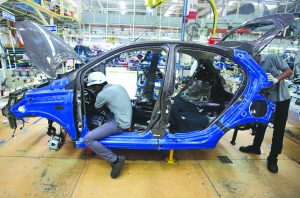 The State Bank of India (SBI) has joined all other global agencies — the ADB, World Bank, OECD, RBI and the IMF — in downgrading India’s financial year 1920 growth rates. The SBI has said in a report released on November 12, 1920, “Based on our composite leading indicator that suggests the GDP growth to slow down further from 5 per cent in Q1 of FY20 to 4.2 per cent on account of low automobile sales, deceleration in air traffic movements, flattening of core sector growth and declining investment in construction and infrastructure.”
The State Bank of India (SBI) has joined all other global agencies — the ADB, World Bank, OECD, RBI and the IMF — in downgrading India’s financial year 1920 growth rates. The SBI has said in a report released on November 12, 1920, “Based on our composite leading indicator that suggests the GDP growth to slow down further from 5 per cent in Q1 of FY20 to 4.2 per cent on account of low automobile sales, deceleration in air traffic movements, flattening of core sector growth and declining investment in construction and infrastructure.”
The second quarter GDP growth may further lower down to 4.2 per cent on low automobile sales, deceleration in air traffic movements, flattening of core sector growth and declining
investment in construction and infrastructure, and the growth forecast for FY20 has now come down to 5 per cent from 6.1 per cent earlier, an SBI report said. India’s GDP was already at the 6-year lowest of 5 per cent in the first quarter. The SBI said “Among meteorological divisions, Central India and Southern Peninsula received the maximum rainfall of 129 per cent and 116 per cent of their LPA, respectively. Excess Monsoon rains and the floods caused by them had affected the Kharif crops in many states, including Madhya Pradesh, Maharashtra, Gujarat, Karnataka and Punjab. While 40 to 50 per cent soyabean crop has been hit in Madhya Pradesh, which is the biggest producer of the oilseed, 30 to 40 per cent of the groundnut and up to 30 per cent of cotton crops have been affected in Gujarat”.
“As these states are major agrarian states, so this could have a negative impact on the agricultural growth. Considering all these domestic parameters along with the global downturn, we now foresee a GDP growth at 5 per cent in the current fiscal,” the report said. “We expect Q2GDP growth at 4.2 per cent. Our acceleration rate for 33 leading indicators at 85 per cent in October 2018 is down to just 17 per cent in September 2019, with such decline gaining traction from March 2019.
Even as the government continues to stress that economic slowdown is cyclical in nature and a recovery will soon be visible, high frequency data suggests otherwise. Interestingly, the prime minister Narendra Modi during the Golden Jubilee of the Aditya Birla Group in Thailand, just days before the release of SBI report had said that he can say with full confidence that “this is the best time to be in India!”
He had claimed that in today’s India, many things are rising and many are falling. ‘Ease of Doing Business’ is rising and so is ‘Ease of Living.’ FDI is rising. Our Forest Cover is rising. The number of patents and trademarks are rising. Productivity and efficiency are rising. Pace of infrastructure creation is rising. Number of people getting top quality healthcare is rising. At the same time, Number of taxes are falling. Tax rates are falling. Red-tapism is falling. Cronyism is falling. Corruption is falling. The corrupt are running for cover. Middlemen in the corridors of power are history.
India received $286 billion FDI in the last five years. This is almost half of the total FDI in India in the last twenty years. 90 per cent of this came through automatic approvals. And 40 per cent of this is Green Field Investment. This shows that investors are taking a long term call on India. India’s growth trajectory is reflected in several ratings. We are among the top 10 FDI destinations as per UNCTAD Moved up twenty four places on the Global Innovation Index of WIPO in five years. But, there are two of them I want to talk about specially. India has jumped 79 places in the World Bank’s ‘Ease of Doing Business’ rankings in five years. From 142 in 2014 we are 63 in 2019. This is a massive achievement . For the third year in row, we are among the top ten reformers.
The other is India’s improved ranking in the World Economic Forum’s Travel and Tourism Competitiveness Index . From 65 in 2013 we are ranked 34 in 2019. This jump is among the biggest. The number of foreign tourist arrivals have also gone up by 50 per cent. India is now pursuing another dream — to become a $5 trillion economy. When my Government took over in 2014, India’s GDP was about $2 trillion. In 65 years, $2 trillion. But in just 5 years, we increased it to nearly $3 trillion. The PM said, “This convinces me that the dream of a $5 trillion economy will soon become a reality. We are going to invest One Point $5 trillion for next generation infrastructure.”
Modi added that India has seen many success stories in the last five years in various sectors. The reason for this is not only the Governments. India has stopped working in a routine, bureaucratic manner. Transformative changes are arising due to ambitious missions undertaken. When these ambitious missions are energised by the partnership of people, they become vibrant mass movements. And, these mass movements achieve miracles. Things that were supposed to be previously impossible have now become possible. Coverage for basic necessities of life have reached almost 100 per cent. Good examples for this are — Jan Dhan Yojana that has ensured near total financial inclusion. And, Swachh Bharat Mission, where sanitation coverage has reached nearly all households.
He said, “In India we faced a big problem when it came to service delivery- leakage. The poor suffered most due to this. You would be shocked to know that for years, money was spent on the poor which did not really reach the poor. Our Government ended this culture thanks to DBT”. DBT stands for direct benefit transfer. DBT has ended the culture of middlemen and inefficiency. It has left little scope for error.
The Prime Minister has figured out that the DBT has saved over $20 billion so far. You would have seen LED lights in homes. You know that they are more efficient and energy conserving. But do you know its impact in India? We have distributed more than 360 million LED bulbs in last few years. We have changed 10 million streetlights to LED lights. Through this, we have saved about three point five billion dollars. Carbon emissions have reduced as well. I firmly believe- money saved is money earned. Energy saved is energy generated. This money is now being used to empower millions through other equally effective programmes.
Indeed there is a paradox in what the hard facts indicate and what the government claims. The only immediate solution for India seems to be to boost consumption through a stimulus given directly to people. Policy intervention is needed immediately in affected sectors to boost economy before it is too late.
letters@tehelka.com












